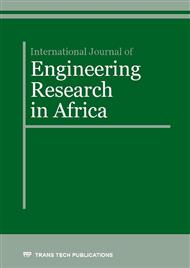[1]
G. Roth and B. i. p. l. r. e. l. développement, The private provision of public services in developing countries: JSTOR, (1987).
Google Scholar
[2]
S. Berry, R. Downs, and S. Reyna, Concentration without privatization? Some consequences of changing patterns of rural land control in Africa, Land and society in contemporary Africa., pp.53-75, (1988).
Google Scholar
[3]
J. I. T. Buertey and S. K. Asare, Public Private Partnership in Ghana: A Panacea to the Infrastructural Deficit?, International Journal of Construction Engineering and Management, vol. 3, pp.135-143, (2014).
Google Scholar
[4]
T. J. Bassett and D. E. Crummey, Land in African agrarian systems: University of Wisconsin Press, (1993).
Google Scholar
[5]
A. K. Jha, K. E. Joynt, E. J. Orav, and A. M. Epstein, The long-term effect of premier pay for performance on patient outcomes, New England Journal of Medicine, vol. 366, pp.1606-1615, (2012).
DOI: 10.1056/nejmsa1112351
Google Scholar
[6]
M. Powell and R. Miller, Framing Privatisation in the English National Health Service, Journal of Social Policy, vol. 43, pp.575-594, (2014).
DOI: 10.1017/s0047279414000269
Google Scholar
[7]
N. Obirih-Opareh, Solid waste collection in Accra: The impact of decentralisation and privatisation on the practice and performance of service delivery: Universiteit van Amsterdam/AGIDS, (2003).
Google Scholar
[8]
A. Pitcher, Was privatisation necessary and did it work? The case of South Africa, Review of African Political Economy, vol. 39, pp.243-260, (2012).
DOI: 10.1080/03056244.2012.688803
Google Scholar
[9]
J. Tooley and P. Dixon, 'De facto'privatisation of education and the poor: implications of a study from sub‐Saharan Africa and India, Compare, vol. 36, pp.443-462, (2006).
DOI: 10.1080/03057920601024891
Google Scholar
[10]
H. C. van Rensburg, South Africa's protracted struggle for equal distribution and equitable access–still not there, Human resources for health, vol. 12, p.1, (2014).
DOI: 10.1186/1478-4491-12-26
Google Scholar
[11]
K. O. Appiah, F. Agyemang, Y. F. R. Agyei, S. Nketiah, and B. J. Mensah, Computerised Accounting Information Systems: Lessons in State-Owned Enterprise in Developing Economies, Journal of Finance and Management in Public Services, vol. 12, (2014).
Google Scholar
[12]
C. Alden and W. Anseeuw, The Struggle over Land in Africa: conflicts, politics & change, (2015).
Google Scholar
[13]
G. Kruss, More, better, different?: understanding private higher education in South Africa, (2015).
Google Scholar
[14]
W. Yip and W. Hsiao, Harnessing the privatisation of China's fragmented health-care delivery, The Lancet, vol. 384, pp.805-818, (2014).
DOI: 10.1016/s0140-6736(14)61120-x
Google Scholar
[15]
W. Otieno, Privatization of Kenyan Public Universities, International Higher Education, (2015).
Google Scholar
[16]
I. Valodia, A. Habib, and R. Ballard, Voices of protest: Social movements in post-apartheid South Africa: University of KwaZulu-Natal Press, (2015).
DOI: 10.1080/02533950608628735
Google Scholar
[17]
L. Balcerowicz, Stabilization and Reforms under Extraordinary and Normal Politics1, The Great Rebirth: Lessons from the Victory of Capitalism over Communism, p.17, (2014).
Google Scholar
[18]
N. Boubakri, J. C. Cosset, and O. Guedhami, Privatisation in developing countries: Performance and ownership effects, Development Policy Review, vol. 26, pp.275-308, (2008).
DOI: 10.1111/j.1467-7679.2008.00411.x
Google Scholar
[19]
M. D. Ochieng and A. H. Ahmed, The Effects of Privatization on the Financial Performance of Kenya Airways, International Journal of Business and Commerce, vol. 3, pp.10-26, (2014).
Google Scholar
[20]
S. Kayizzi-Mugerwa, A. Shimeles, and N. D. Yaméogo, Urbanization and Socio-economic Development in Africa: Challenges and Opportunities: Routledge, (2014).
DOI: 10.4324/9781315780023
Google Scholar
[21]
C. C. Chen, Corporate governance of state-owned enterprises: an empirical survey of the model of Temasek Holdings in Singapore, Singapore Management University School of Law Research Paper, pp.1-29, (2014).
DOI: 10.2139/ssrn.2366699
Google Scholar
[22]
C. Eckel, D. Eckel, and V. Singal, Privatization and efficiency: Industry effects of the sale of British Airways, Journal of Financial Economics, vol. 43, pp.275-298, (1997).
DOI: 10.1016/s0304-405x(96)00893-8
Google Scholar
[23]
P. Choudhury and T. Khanna, Toward resource independence–Why state-owned entities become multinationals: An empirical study of India's public R&D laboratories, Journal of International Business Studies, vol. 45, pp.943-960, (2014).
DOI: 10.1057/jibs.2014.20
Google Scholar
[24]
S. Clo, C. Del Bo, M. Ferraris, C. V. Fiorio, M. Florio, and D. Vandone, Publicization versus Privatization: Recent worldwide evidence, (2014).
DOI: 10.2139/ssrn.2589180
Google Scholar
[25]
A. Engvall and S. N. Linn, Myanmar Economic Update: Macroeconomy, Fiscal Reform, and Development Options, Debating Democratization in Myanmar, vol. 233, p.159, (2014).
DOI: 10.1355/9789814519151-015
Google Scholar
[26]
J. Fu and H. Lu, Structural Changes in Chinese Stock Market: A Review of Empirical Research, China Accounting and Finance Review, (2014).
DOI: 10.7603/s40570-014-0006-2
Google Scholar
[27]
L. C. García and S. G. Ansón, Governance and performance of Spanish privatised firms, Corporate Governance: An International Review, vol. 15, pp.503-519, (2007).
DOI: 10.1111/j.1467-8683.2007.00584.x
Google Scholar
[28]
T. A. Haque, Economic Transition in Solomon Islands, (2014).
Google Scholar
[29]
K. Hartley, D. Parker, and S. Martin, Organisational status, ownership and productivity, Fiscal Studies, vol. 12, pp.46-60, (1991).
DOI: 10.1111/j.1475-5890.1991.tb00156.x
Google Scholar
[30]
N. Huyghebaert, Q. Quan, and L. Sun, Financing decisions after partial privatization in China: Can a stock market quotation really provide discipline?, Journal of Financial Intermediation, vol. 23, pp.27-46, (2014).
DOI: 10.1016/j.jfi.2013.08.005
Google Scholar
[31]
S. R. Jory and T. N. Ngo, Cross-border acquisitions of state-owned enterprises, Journal of International Business Studies, vol. 45, pp.1096-1114, (2014).
DOI: 10.1057/jibs.2014.41
Google Scholar
[32]
M. Kanyane and K. Sausi, Reviewing state-owned entities' governance landscape in South Africa, African Journal of Business Ethics, vol. 9, (2015).
DOI: 10.15249/9-1-81
Google Scholar
[33]
H. -A. Lee, Affirmative action regime formation in Malaysia and South Africa, Journal of Asian and African Studies, p.0021909614550895, (2014).
Google Scholar
[34]
L. Liao, B. Liu, and H. Wang, China׳ s secondary privatization: Perspectives from the Split-Share Structure Reform, Journal of Financial Economics, vol. 113, pp.500-518, (2014).
DOI: 10.1016/j.jfineco.2014.05.007
Google Scholar


